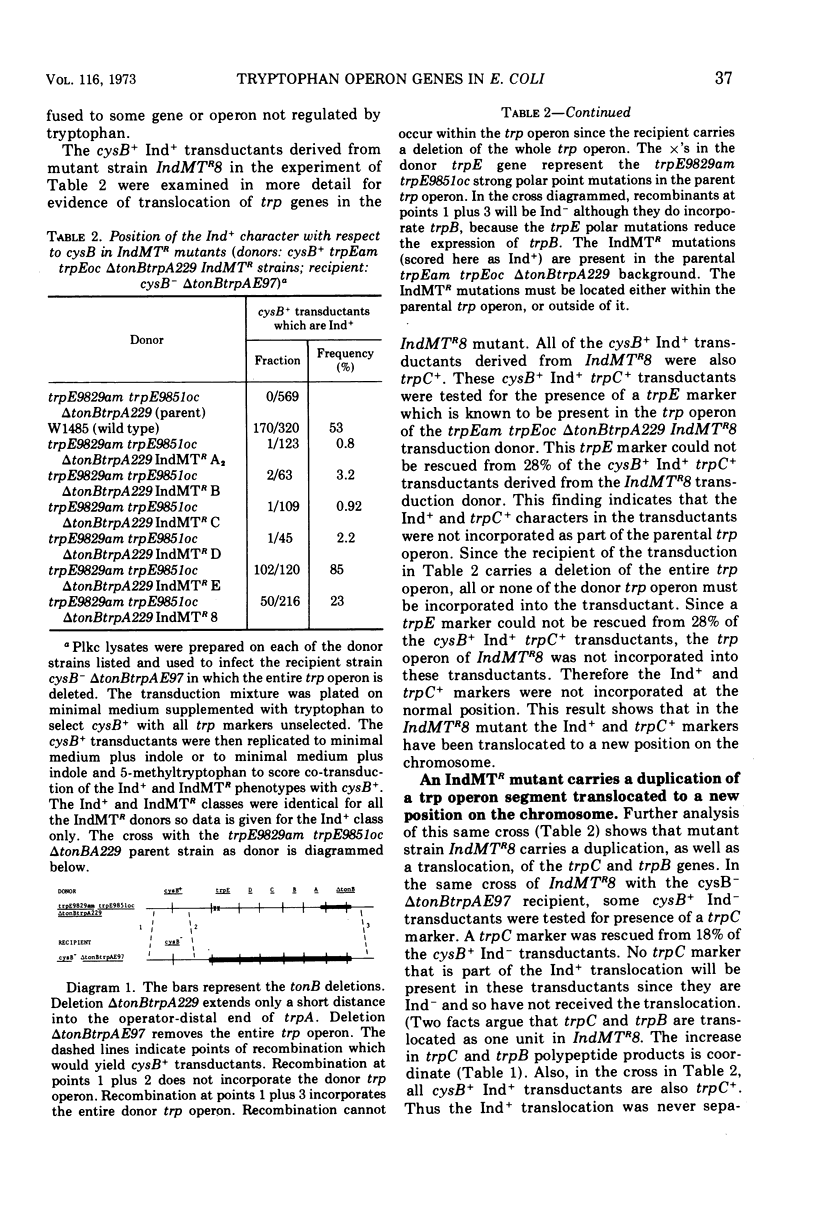Abstract
Mutants of Escherichia coli were selected in which a single mutational event had both relieved the polar effect of an early trpE mutation on trpB and simultaneously released the expression of trpB from tryptophan repression. The frequency at which these mutations appeared was roughly equal to the frequency of point mutations. In each of these mutants, the mutation increased the function of trpB and also increased the activity of some, but not all, of the other four tryptophan operon genes. Genetic analysis showed that the mutations were not located within the trp operon since in each case the parental trp operon could be recovered from the mutants. Each mutant was shown to carry a duplication of a trp operon segment translocated to a new position near the trp operon. Polarity is relieved since the trpB duplication-translocation is not in the same operon as the trpE polar mutation. The duplicated and translocated segments are fused to operons not regulated by tryptophan, so trpB function is no longer subject to tryptophan repression. The properties of the mutants indicate that the length of the duplicated segment and the position to which it is translocated differ in each of the seven mutants studied. The duplications are unstable, but the segregation pattern observed is not consistent with a single crossover model for segregation. That such duplication-translocation events generate a variety of new genetic arrangements at a frequency comparable with point mutations suggests they may play an important role in evolution.
Full text
PDF







Selected References
These references are in PubMed. This may not be the complete list of references from this article.
- Folk W. R., Berg P. Duplication of the structural gene for glycyl-transfer RNA synthetase in Escherichia coli. J Mol Biol. 1971 Jun 14;58(2):595–610. doi: 10.1016/0022-2836(71)90374-3. [DOI] [PubMed] [Google Scholar]
- HORIUCHI T., HORIUCHI S., NOVICK A. The genetic basis of hyper-synthesis of beta-galactosidase. Genetics. 1963 Feb;48:157–169. doi: 10.1093/genetics/48.2.157. [DOI] [PMC free article] [PubMed] [Google Scholar]
- Hill C. W., Foulds J., Soll L., Berg P. Instability of a missense suppressor resulting from a duplication of genetic material. J Mol Biol. 1969 Feb 14;39(3):563–581. doi: 10.1016/0022-2836(69)90146-6. [DOI] [PubMed] [Google Scholar]
- Jackson E. N., Yanofsky C. Internal deletions in the tryptophan operon of Escherichia coli. J Mol Biol. 1972 Nov 14;71(2):149–161. doi: 10.1016/0022-2836(72)90343-9. [DOI] [PubMed] [Google Scholar]
- Jackson E. N., Yanofsky C. Internal promoter of the tryptophan operon of Escherichia coli is located in a structural gene. J Mol Biol. 1972 Aug 21;69(2):307–313. doi: 10.1016/0022-2836(72)90232-x. [DOI] [PubMed] [Google Scholar]
- Morse D. E., Yanofsky C. A transcription-initiating mutation within a structural gene of the tryptophan operon. J Mol Biol. 1969 May 14;41(3):317–328. doi: 10.1016/0022-2836(69)90278-2. [DOI] [PubMed] [Google Scholar]
- Morse D. E., Yanofsky C. The internal low-efficiency promoter of the tryptophan operon of Escherichia coli. J Mol Biol. 1968 Dec;38(3):447–451. doi: 10.1016/0022-2836(68)90401-4. [DOI] [PubMed] [Google Scholar]
- VOGEL H. J., BONNER D. M. Acetylornithinase of Escherichia coli: partial purification and some properties. J Biol Chem. 1956 Jan;218(1):97–106. [PubMed] [Google Scholar]
- Yanofsky C., Horn V., Bonner M., Stasiowski S. Polarity and enzyme functions in mutants of the first three genes of the tryptophan operon of Escherichia coli. Genetics. 1971 Dec;69(4):409–433. doi: 10.1093/genetics/69.4.409. [DOI] [PMC free article] [PubMed] [Google Scholar]


